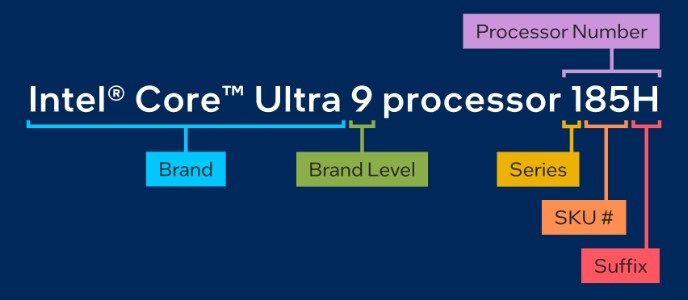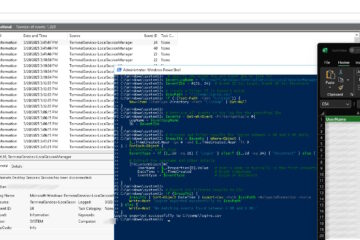If you’ve been following the stock market or the chip industry in any way you will know that Intel started falling behind competitors in the early 2010’s. Companies like TSMC are now a generation ahead of Intel in manufacturing, while AMD and ARM (which sell their designs to thousands of other companies including Apple, Microsoft and Google) were at least one generation ahead of Intel on performance.
That’s all changing with the introduction of the Intel Core Ultra brand. Yes, Intel is still going to produce i- Series branded chips for a few more years, but make no mistake, Ultra is the future. So what is Intel Core Ultra?
Put simply, Intel Core Ultra is just the next generation of Intel CPUs. So you can think of them as Intel Core i-Series generation 15. You may have even read that both the Intel Core Ultra and Intel Core i-series use “Ocean Cove” CPU cores made on the same 7nm lithography process, and that is true.
However, if you just blow these off as the next version you are really missing the point. Intel doesn’t rebrand everyday, so they are trying to signal that there is something big happening here… and it is.
Below is what can only be described as an eye-chart, meaning that there is way too much information for the average person to take in. But it does nicely summarize all of the things you need to know about some of the more Core Ultra’s if you look closely:
Click to Expand Graphic

Note: We have a badly fitting copy of this graphic added in a table at the bottom of this page if you need to copy/paste for some reason
So if the underlying CPU’s cores are the same, what makes Intel Core Ultra different from core i-Series? We can get pretty weedy explaining the uber-techy details on this but it really boils down to two things:
- NPU’s:
The latest generation of Intel i-Series CPU’s have a single NPU (Neural Processing Unit) which is used to handle Artificial Intelligence related work, but the Intel Core Ultra’s have two NPU’s. That’s twice as good. - LE-Efficiency Cores:
If you followed the last couple of versions of Intel CPU’s you’ll know that they introduced low power so called “Efficiency Cores” to run most of the day to day operations of your computer. Intel Core Ultra Introduces a new even lower low power category of CPU cleverly called LP-Efficiency Cores, and your Core Ultra’s have two of them. This means your Intel Core Ultra CPU, now has three different CPU’s:- “Ocean Cove” Performance Cores – Think of them as the latest and greatest
- “Lion Cove” Efficiency Cores – Think of them as i5 CPU’s from about 2016
- “Skymont” LP-Efficiency Cores – Think of them as REALLY efficient and tiny i5’s from about 2016
What’s The Same Between the Intel Core Ultra and 14th Gen i-Series?
Beyond that the latest generation of both the Intel Core i-Series and Core Ultra have some massive improvements over the previous generations. Given that we are sure the Intel Core i-Series will be relegated to history in the coming years as AI demands take over CPU’s, you should be aware of those improvements:
ARCHITECTURE:
Intel CPU’s now are built on a independent “Tiles”. Think of this as a super-lego baseplate which allows Intel to snap different “tiles” onto. The novelty lies in the fact that these tiles can be, and are being, produced by various companies using distinct manufacturing processes, yet they can all be integrated into a single “CPU package”.

In the case of Core Ultra:
- the Graphics tile on the H-Series are engineered Intel Arc Xe’s, but actually manufactured by arch rival TSMC using a 5nm process that Intel just can’t match yet
- the main real cores are “Ocean Cove” manufactured by Intel at 7nm
- the SoC tile is another TSMC product that is 6nm
- the Intel Skymont LP-Efficiency cores are yet another TSMC product built at a tiny 3nm
Its definitely innovative and will help Intel take a giant leap forward. Now Intel can source the best CPU components from any company anywhere in the world, at the lowest cost.
UPGRADABLE WIFI?
Yes, the WiFi networking tile can be software (well, firmware) upgraded from its current WiFi 6 standard to the WiFi 7 in the coming years
ONLY DDR5 MEMORY
DDR4, first used in mainstream computers in 2015, is now defunct. Intel Core Ultra and Intel Core i-Series 14th Generation CPU’s now only work with DDR5 memory, which is twice as fast.
WHAT IS AN SoC?
SoC or “System on Chip” is the magic bridge between all the different “cores” on Intel’s latest chips and it allows Intel to be drastically more flexible in the future.
What’s the Difference Between Intel Core Ultra H & U
H stands for high performance, where as U refers to ultra mobile (focus on battery life, size, and heat) so it will come as no surprise the Core Ultra H-Series processors have double or triple the number of ‘Performance Cores” and have much better video capability named Intel Arc, but H-Series CPU’s use two to 3 times as much electricity.

Intel Core Ultra Naming Convention Explained
As you can see in the graphic below Intel has a naming convention for its new core Ultra CPU’s but really the only thing that matters at all is the last four characters. Specifically if you look at the table above which details a bunch of specifications for the these processors you will see that the Intel Ultra five seven and 9 really mean nothing. Further, Intel and the word core don’t add much either.
The last numbers are important:
- FIRST NUMBER = Series – We are currently at the first series of Intel Core Ultra CPU’s, so it is a 1. In a couple of years they’ll bring out the next generation and so that number will change to a “2”
- REMAINING NUMERS = SKU – That is Intel’s internal number which is completely symbolic but does not directly relate to any specific technology. Generally speaking the higher the number the better their performance but we already know there are a couple of situations where that isn’t the case so you’re going to want to check the exact specifications before making a purchase.
- LETTER = Series – Currently there are only H and U Intel Core Ultra CPU’s but more will be added in the future. This letter is arguably the most important thing you should be considering in CPU today.
- We have a list of all the current Intel CPU Suffixes and what they mean. We think it is highly unlikely Intel will not have an Core Ultra K series CPU for overclocking gamers… but it does not exist at the time of publication.
If you are still struggling to figure all this out, you might find our short article on which Intel Core Ultra CPU is the best for corporate use to be enlightening.
Summary
The latest generation of Intel CPU’s is truly a giant leap forward for the company that will help them catch up to their global competition, and power “so called” AI computers.
Because the new CPU’s from Intel are not notably more expensive than the previous generation they are the only ones most people and companies should be buying. Intel core ultra CPU’s are available now and we just bought our first corporate Dell Latitude 5450 with an Intel Core Ultra 5 125U for less than USD $1000.
If you’re still reading this far down, you’re probably interested in which Intel Core Ultra CPU your company should buy and we decided to put up a separate article on that right here.
Text Table of Intel Core Ultra Specifications
| Intel Branding | Processor Number | Cores / Threads | P-cores | E-cores | LP E-cores | Cache | Max Turbo Freq P-core | Max Turbo Freq E-core | GPU Integrated | GPU Max Freq | GPU XE Cores | Neural Processor | Neural Compute Engines | Max Memory Capacity | Max Memory Speed | Electricity Consumption Normal (W) | Electricity Consumption on Turbo (W) | |
| H | Intel Core Ultra 9 | 185H | 16/22 | 6 | 8 | 2 | 24M | 5.1 | 3.8 | Intel ArcTM GPU | 2.35 | 8 | Intel Al Boost | 2x Gen3 | 64GB (LP5) 96GB (DDR5) | DDR5-5600 LPDDR5/x-7467 | 45 | 64, 115 |
| Intel Core Ultra 7 | 165H | 16/22 | 6 | 8 | 2 | 24M | 5.0 | 3.8 | Intel ArcTM GPU | 2.3 | 8 | Intel Al Boost | 2x Gen3 | 64GB (LP5) 96GB (DDR5) | DDR5-5600 LPDDR5/x-7467 | 28 | 64, 115 | |
| Intel Core Ultra 7 | 155H | 16/22 | 6 | 8 | 2 | 24M | 4.8 | 3.8 | Intel ArcTM GPU | 2.25 | 8 | Intel Al Boost | 2x Gen3 | 64GB (LP5) 96GB (DDR5) | DDR5-5600 LPDDR5/x-7467 | 28 | 64, 115 | |
| Intel Core Ultra 5 | 135H | 14/18 | 4 | 8 | 2 | 18M | 4.6 | 3.6 | Intel ArcTM GPU | 2.2 | 7 | Intel Al Boost | 2x Gen3 | 64GB (LP5) 96GB (DDR5) | DDR5-5600 LPDDR5/x-7467 | 28 | 64, 115 | |
| Intel Core Ultra 5 | 125H | 14/18 | 4 | 8 | 2 | 18M | 4.5 | 3.6 | Intel ArcTM GPU | 2.2 | 7 | Intel Al Boost | 2x Gen3 | 64GB (LP5) 96GB (DDR5) | DDR5-5600 LPDDR5/x-7467 | 28 | 64, 115 | |
| U | Intel Core Ultra 7 | 165U | 12/14 | 2 | 8 | 2 | 12M | 4.9 | 3.8 | Intel Graphics | 2 | 4 | Intel Al Boost | 2x Gen3 | 64GB (LP5) 96GB (DDR5) | DDR5-5600 LPDDR5/x-7467 | 15 | 57 |
| Intel Core Ultra 7 | 164U | 12/14 | 2 | 8 | 2 | 12M | 4.8 | 3.8 | Intel Graphics | 1.8 | 4 | Intel Al Boost | 2x Gen3 | 64GB (LP5) 96GB (DDR5) | DDR5-5600 LPDDR5/x-7467 | 9 | 30 | |
| Intel Core Ultra 7 | 155U | 12/14 | 2 | 8 | 2 | 12M | 4.8 | 3.8 | Intel Graphics | 1.95 | 4 | Intel Al Boost | 2x Gen3 | 64GB (LP5) 96GB (DDR5) | DDR5-5600 LPDDR5/x-7467 | 15 | 57 | |
| Intel Core Ultra 5 | 135U | 12/14 | 2 | 8 | 2 | 12M | 4.4 | 3.6 | Intel Graphics | 1.9 | 4 | Intel Al Boost | 2x Gen3 | 64GB (LP5) 96GB (DDR5) | DDR5-5600 LPDDR5/x-7467 | 15 | 57 | |
| Intel Core Ultra 5 | 134U | 12/14 | 2 | 8 | 2 | 12M | 44 | 3.6 | Intel Graphics | 1.75 | 4 | Intel Al Boost | 2x Gen3 | 64GB (LP5) 96GB (DDR5) | DDR5-5600 LPDDR5/x-7467 | 9 | 30 | |
| Intel Core Ultra 5 | 125U | 12/14 | 2 | 8 | 2 | 12M | 4.3 | 3.6 | Intel Graphics | 1.85 | 4 | Intel Al Boost | 2x Gen3 | 64GB (LP5) 96GB (DDR5) | DDR5-5600 LPDDR5/x-7467 | 15 | 57 |



1 Comment
Saud · July 1, 2024 at 1:12 am
This is genius! There is so much hype of the Core Ultra, I couldn’t tell what was what. Explaining the two big diferences… now it makes a lot of sense. Is Intel back? I hope so.